National Symbols of India: Every country has its own distinct identity and national symbols play an important role in creating this identity. National symbols are the heritage of the country, on which every citizen of the country is proud.
India also has many national symbols and every Indian has pride in it. As a citizen of the country, you should know about the National Symbols of India. Here we will give information about the National Flag of India, National Anthem of India, National Song of India, National Animal of India, National Bird of India, National Flower of India, National Fruit of India, National Tree of India, National Currency of India, National River of India, National Calendar of India, National Day of India and some other symbols.
Here is the complete list of the National Symbols of India.
|
Sr. no |
National Symbol |
Symbol Name |
|
1. |
Nationality |
Indian |
|
2. |
National Flag |
Tricolor |
|
3. |
National Emblem |
State Emblem of India |
|
4. |
National Anthem |
Jan-Gan-Man |
|
5. |
National Song |
Vande Mataram |
|
6. |
National Animal |
Tiger |
|
7. |
National Bird |
Peacock |
|
8. |
National Flower |
Lotus |
|
9. |
National Fruit |
Mango |
|
10. |
National Tree |
Banyan |
|
11. |
National Currency |
Indian Rupee |
|
12. |
National River |
Ganga |
|
13. |
National Reptile |
King Cobra |
|
14. |
National Aquatic Animal |
Ganges River Dolphin |
|
15. |
National Heritage Animal |
Elephant |
|
16. |
National Calendar |
Indian National Calendar |
|
17. |
National Language |
Hindi (State Language of India) |
|
18. |
National Sweet |
- |
|
19. |
National Vegetable |
- |
|
20. |
National Festival |
26 January (Republic Day), 15 August (Independence Day), 2 October (Gandhi Jayanti) |
|
21. |
National Dish/Food |
Khichadi |
|
22. |
National Game/Sport |
- |
|
23. |
National Script |
Devanagari (Official Script of India) |
|
24. |
Highest National Award |
Bharat Ratna |
|
25. |
National Motto |
Satyamev Jayate |
|
26. |
National Oath |
Oath of Allegiance |
Get the detailed information here -
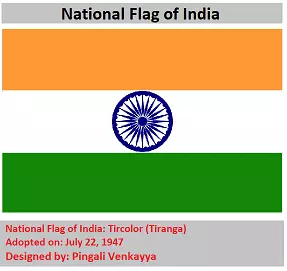
The National Flag of India is a horizontal rectangular tricolor (Tiranga) of India and it has three colors - saffron (at the top), white (at the middle) and green (at the bottom) with a 24-spoke wheel, in navy blue at its center. This Chakra is taken from the Ashoka Pillar located at Sarnath.
Saffron: Saffron is a symbol of courage, strength and sacrifice of the Country.
White: The color white represents honesty, peace and purity. Green: Green represents faith and chivalry. It is a symbol of prosperity, vibrancy and life.
Ashoka Chakra: The Ashoka Chakra or Dharma Chakra (Wheel of Law) has 24 spokes and appears on many Ashokan inscriptions.
Indian Constituent Assembly adopted the national flag tricolor on july 22, 1947 And it became the official flag of the Dominion of India on 15 August 1947.
The National Flag of India was designed by Pingali Venkayya.
The ratio of the length and width of the flag is 2:3.
The late Prime Minister Jawaharlal Nehru said "A flag of freedom not only for oneself but a symbol of the freedom of all people".
The first national flag in India was hoisted on August 7, 1906 at Parsi Bagan Square (Green Park) in Kolkata.
The design and manufacturing process for the national flag is governed by three documents issued by the Bureau of Indian Standards (BIS).
Some Important Points About Indian National Flag.
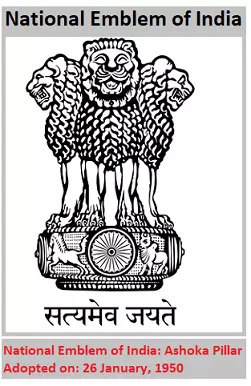
The Ashoka Pillar is the national emblem of India. The Ashoka Pillar is derived from the pillar built by Emperor Ashoka of the Maurya Empire at Sarnath.
The original Sarnath capital has four Asiatic lions standing one after the other, symbolizing strength, courage, confidence and pride, mounted on a circular base. At the bottom is a horse and a bull, and in its center is a Dharma Chakra.
The capital has four Asiatic lions – a symbol of strength, courage, pride and confidence – perched on a circular abacus.
The abacus is girded with a frieze of sculptures in high relief of The Lion of the North, The Horse of the West, The Bull of the South, and The Elephant of the East, separated by intervening wheels, over a lotus in full bloom, exemplifying the fountainhead of life and creative inspiration. Carved from a single block of sandstone, the polished capital is crowned by the Wheel of the Law.
Forming an integral part of the emblem is the motto inscribed at the bottom of the abacus in Devanagari script: Satyameva Jayate (Truth alone triumphs"). This is a quote from the Mundaka Upanishad, the last part of the sacred Hindu Vedas.
The use of the emblem is regulated and restricted under the State Emblems of India (Prohibition of Improper Use) Act, 2005, under which, no individual or private organization is permitted to use the emblem for official correspondence.
On 26 January 1950, the lion capital representation of Ashoka atop the motto, Satyameva Jayate, was adopted as the state emblem of India.
The National Anthem of India is Jana-Gana-Mana. The song was originally composed in Bengali by India's first Nobel laureate Rabindranath Tagore on December 11, 1911. It was originally composed in Bengali as ‘Bharato Bhagya Bidhata’.
The first stanza of the song Bharato Bhagya Bidhata was adopted as the national anthem of India by the Constituent Assembly of India on 24 January 1950.
It was sung publicly for the first time on 27 December 1911 at the Calcutta (now Kolkata) session of the Indian National Congress.
The original poem was translated into Hindi by Abid Ali and the original Hindi version of the song was slightly different.
The song was chosen as the national anthem by Subhash Chandra Bose while in Germany. On 11 September 1942, Jana Gana Mana as the national anthem of independent India was played for the first time by the Hamburg Radio Symphony Orchestra on the occasion of the founding meeting of the German-Indian Society at the Hotel Atlantic in Hamburg.
The approximate duration of the full version of the national anthem of India is 52 seconds and 20 seconds for the shorter version.
The national anthem tells us that India is a diverse nation and there are differences in culture, traditions, religions, and languages, but despite these differences, it reminds us that India is united under one flag.
The Indian National Anthem is played or sung on various occasions. From government offices to schools and colleges, the national anthem of India is sung on special occasions or national holidays or even daily as it is also known as "India's morning song".
The national anthem of India is respected. All residents are required to stand when the national anthem is played or sung.
Official Lyrics of the National Anthem of India
|
जन-गण-मन अधिनायक जय हे, भारत भाग्य विधाता! पंजाब-सिंधु-गुजरात-मराठा, द्राविड़-उत्कल-बंग विंध्य हिमाचल यमुना गंगा, उच्छल जलधि तरंग तव शुभ नामे जागे, तव शुभ आशिष मागे गाहे तव जय गाथा। जन-गण-मंगलदायक जय हे, भारत भाग्य विधाता! जय हे! जय हे! जय हे! जय जय जय जय हे! |
Jana-gana-mana adhinayaka jaya he Bharata-bhagya-vidhata Panjaba-Sindhu-Gujarata-Maratha Dravida-Utkala-Banga Vindhya-Himachala-Yamuna-Ganga Uchchala-jaladhi-taranga Tava Subha name jage, Tava subha asisa mage, gahe tava jaya-gatha. Jana-gana-mangala-dayaka jaya he Bharata-bhagya-vidhata. Jaya he, Jaya he, Jaya he, Jaya jaya jaya jaya he. |
On some occasions a shortened version of the first and last lines of the national anthem is also played. These are the lines -
|
जन-गण-मन अधिनायक जय हे भारत भाग्य विधाता । जय हे, जय हे, जय हे, जय जय जय जय हे । |
Jana-gana-mana-adhinayaka jaya he Bharata-bhagya vidhata. Jaya he, Jaya he, Jaya he, Jaya jaya jaya jaya he. |
The National Song of India is Vande Mataram. Vande Mataram is a poem written in Bengali by Bankim Chandra Chatterjee in the 1870s, which he included in his 1882 Bengali novel Anandamath.
The poem was first sung by Rabindranath Tagore in the 1896 session of the Indian National Congress.
The first two verses of the song were adopted as the national anthem of India in October 1937 by the Congress Working Committee before the end of colonial rule in August 1947.
The Constituent Assembly of India adopted "Vande Mataram" as a national song on 24 January 1950.
The first President of India, Rajendra Prasad, said that the song should be honored equally with the national anthem of India, "Jana Gana Mana". However, there is no mention of a "national song" in the Constitution of India.
On 20 November 1909, the entire poem translated into prose by Sri Aurobindo appeared in a weekly newspaper, Karmayogin. Sri Aurobindo also translated Vande Mataram into a verse structure, known as "Mother, I Bow to Thee".
Official Lyrics of National Song of India
|
वन्दे मातरम् सुजलां सुफलाम् मलयजशीतलाम् शस्यश्यामलाम् मातरम्। शुभ्रज्योत्स्नापुलकितयामिनीम् फुल्लकुसुमितद्रुमदलशोभिनीम् सुहासिनीं सुमधुर भाषिणीम् सुखदां वरदां मातरम्।। सप्त-कोटि-कण्ठ-कल-कल-निनाद-कराले द्विसप्त-कोटि-भुजैर्धृत-खरकरवाले, अबला केन मा एत बॅले बहुबलधारिणीं नमामि तारिणीं रिपुदलवारिणीं मातरम्।। तुमि विद्या, तुमि धर्म तुमि हृदि, तुमि मर्म त्वम् हि प्राणा: शरीरे बाहुते तुमि मा शक्ति, हृदये तुमि मा भक्ति, तोमारई प्रतिमा गडी मन्दिरे-मन्दिरे।। त्वम् हि दुर्गा दशप्रहरणधारिणी कमला कमलदलविहारिणी वाणी विद्यादायिनी, नमामि त्वाम् नमामि कमलाम् अमलां अतुलाम् सुजलां सुफलाम् मातरम्।। वन्दे मातरम् श्यामलाम् सरलाम् सुस्मिताम् भूषिताम् धरणीं भरणीं मातरम्।। |
Vande Mataram! Sujalam suphalam, malayaja shitalam, Shasyashyamalam, Mataram! Shubhrajyotsna pulakitayaminim, Phullakusumita drumadala shobhinim, Suhasinim, sumadhura bhashinim, Sukhadam, varadam, Mataram! Saptakotikantha kalakala ninada karale Dvisaptakoti bhujair dhrita-khara karavale Abala kena ma eta bale Bahubala dharinim, namami tarinim, Ripudalavarinim Mataram! Tumi vidya, tumi dharma, Tumi hridi, tumi marma, Tvam hi pranah sharire! Bahute tumi ma shakti, Hridaye tumi ma bhakti, Tomarayipratima gari mandire mandire! Tvam hi Durga dashapraharana dharini, Kamala, Kamaladalaviharini, Vani, vidyadayini namami tvam, Namami Kamalam, amalam, atulam, Sujalam, suphalam, Mataram, Vande Mataram! Shyamalam, saralam, susmitam, bhushitam, Dharanim, bharanim, Mataram! |
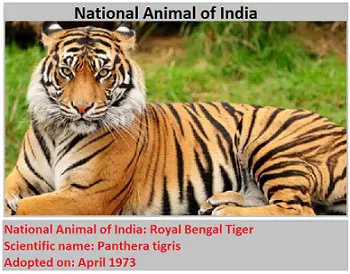
The National Animal of India is the Royal Bengal Tiger. The Bengal tiger was declared the national animal of India in April 1973, with the launch of Project Tiger to protect tigers in India. It was launched from Jim Corbett National Park in Uttarakhand.
Its scientific name is Panthera tigris tigris.
The splendid tiger, Panthera tigris, is a striped animal. It has a thick yellow coat of fur with dark stripes. The combination of grace, strength, agility, and immense strength has earned the tiger its pride as the national animal of India.
Of the eight known species, the royal Bengal tiger (tiger) is found throughout the country except in the north-eastern regions and is also found in neighboring countries, such as Nepal, Bhutan, and Bangladesh. Project Tiger (Tiger Project) was started in April 1973 to check the declining population of tigers in India. So far, 27 tiger reserves have been established under this project covering an area of 37,761 sq. km.
Until 1972, the Lion was the national animal of India. The tiger is the national animal of Bangladesh, South Korea, Vietnam, and Malaysia.
As of 2018, according to the National Tiger Conservation Authority, there were only 2,967 tigers in existence in India which is 70 percent of the global tiger population.
Madhya Pradesh has the highest number of tigers (526) in the age group of 1.5 years with over 408 big cats. Other states with significant populations include Uttarakhand (442), Karnataka (524), Tamil Nadu (229), Maharashtra (190), and Assam (167), Kerala (136), and Uttar Pradesh (117).
There are a total of 53 Tiger Reserves in India as of 2022.
Note: Guru Ghasidas National Park of Chhattisgarh will be the 53rd Tiger Reserve of India approved by the National Tiger Conservation Authority.
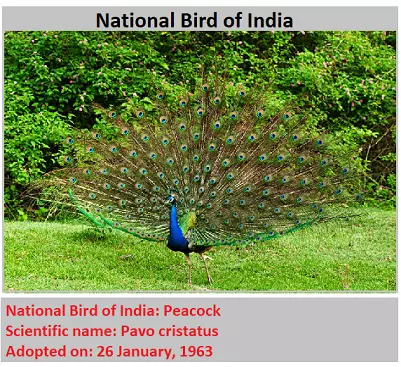
The National Bird of India is the Indian Peacock. Its scientific name is Pavo cristatus. Peacock is a very beautiful, shy, and clever bird of our forest. It was declared the national bird of India in 1963 as it was completely part of Indian customs and culture.
National Bird of India A colorful, swan-shaped bird with a fan-shaped feather crest, white spots below the eyes, and a long slender neck. The male of this species is more colorful than the female, with a bright blue chest and neck and a stunning bronze-green tuft of 200 long feathers. The female is brown in color, slightly smaller than the male, and does not have a tuft of feathers.
The Indian peacock has earned the distinction of being the national bird of the world's largest democracy.
It is considered a symbol of the cleanliness and beauty of India.
Along with the peacock, the names of stork crane, Brahmin kite, bustard, and swan were also discussed in the meeting held in Ooty, Tamil Nadu, and finally, the peacock was declared the national bird of India on 26 January 1963.
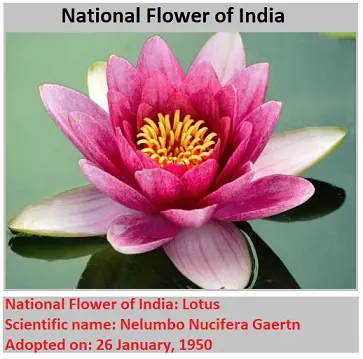
The National Flower of India is Lotus. The scientific name of Lotus is Nelumbo Nucifera Gaertn.
It was adopted as the National Flower of India in 1950.
Lotus is found in white, red, blue, pink and purple colors and is mainly found in Asian countries.
It is a sacred flower and holds a special place in the art and mythology of ancient India.
In Hinduism and mythology, Goddess Saraswati is depicted as the goddess of learning/learning on a lotus flower.
It is also a symbol of victory as the lotus lies in the mud and can live to sprout again for thousands of years. It represents long life, honor and good fortune.
Lotus is a symbol of purity, beauty, opulence, grace, fertility, wealth, prosperity, wisdom and peace.
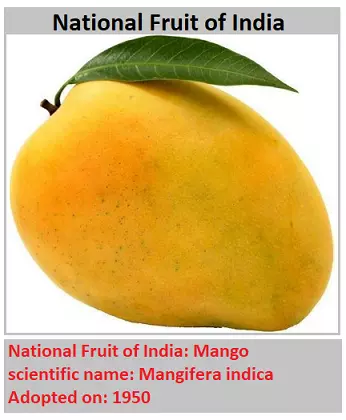
The National fruit of India is Mango. The scientific name of Mango is Mangifera indica. It is also the national fruit of Pakistan and the Philippines.
Mango tree is the national tree of Bangladesh.
Mango (Mangifera indica) is affectionately called the ‘king of fruits’.
As the national fruit of India, it represents prosperity, abundance and prosperity favoring the image of the country.
The Mughal emperor Akbar planted more than 1,00,000 mango saplings in Darbhanga, Bihar, which is now known as Lakhi Bagh.
In 2020, world production of mango (the report includes mangosteen and guava) stood at 55 million tonnes, led by India at 45% of the total (table). About half of the world's mangoes are cultivated in India alone, with the second largest source being Indonesia. Although India is the largest producer of mangoes, it accounts for less than 1% of the international mango trade; India consumes most of its production.
Major mango-producing countries in total tonnage produced in 2020 were Indonesia, China, Pakistan, Mexico, Brazil, Bangladesh, Nigeria, and the Philippines.
More than 100 varieties of mangoes are found in India in a variety of colors, shapes, and sizes. Common names used to refer to the fruit are mango, manga, and mangou.
Loved around the world for its sweet juiciness and bright colors, mangoes are known to be rich in vitamins A, C, and D.
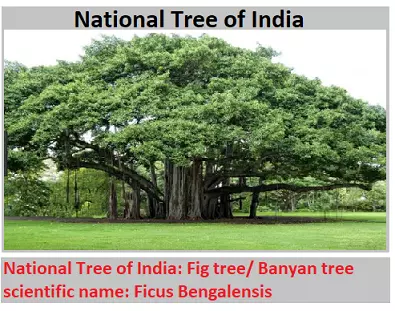
The National Tree of India is an Indian fig tree, also known as the Banyan tree. The scientific name of the tree is Ficus Bengalensis. The national tree of a country is one of the symbols of pride which is an integral part of the identity of the nation.
The tree is often a symbol of 'Kalpa Vriksha' or 'tree of wish fulfillment as it is associated with longevity and has important medicinal properties.
The National Currency of India is Indian Rupee (INR). The issuance of currency is regulated by the Reserve Bank of India.
An official symbol for Indian currency was chosen on 15 July 2010 and was designed by Professor D. Udaya Kumar of IIT, Guwahati.
The Indian currency has become the fifth currency to be identified by its symbol after the US Dollar, British Pound, Japanese Yen, and European Union Euro.
The rupee is subdivided into 100 paise, although as of 2019, coins of the denomination of Re 1 are of the lowest denomination in use.
The National River of India is the Ganga.
It was declared a national river of India by Prime Minister Manmohan Singh in 2008 to achieve the objectives of the Ganga Action Plan launched by Prime Minister Rajiv Gandhi in 1985.
In Hinduism, the Ganges is considered a very sacred river and is also worshiped.
Ganga is the longest river in India (2,525 km).
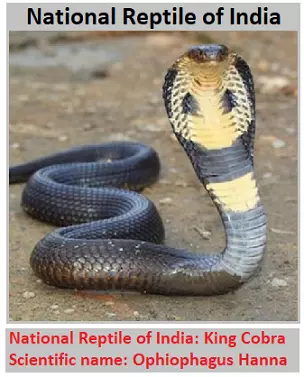
‘King Cobra’ is the National Reptile of India. Its scientific name is Ophiophagus Hanna.
The king cobra is a venomous snake species of elapids endemic to forests in southern and southeast Asia.
Regarded as the national reptile of India, this species has a prominent place in the mythology and folk traditions of India, Sri Lanka, and Myanmar. Threatened by habitat destruction, the king cobra has been listed as Vulnerable on the IUCN Red List since 2010.
Its average length is 5.6 to 5.7 meters.
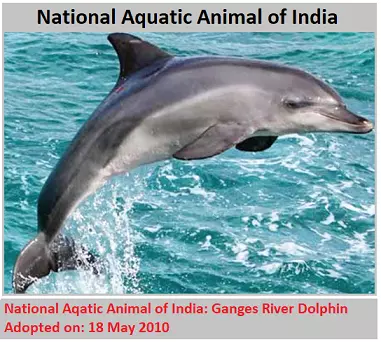
The National Aquatic animal of India is ‘Ganges River Dolphin’. Ganges dolphins are found in the river systems of Ganga, Brahmaputra, Meghna, and Karnaphuli-Sangu in Nepal, India, and Bangladesh.
The Ministry of Environment and Forests notified the Ganges River Dolphin as the National Aquatic Animal on 18 May 2010.
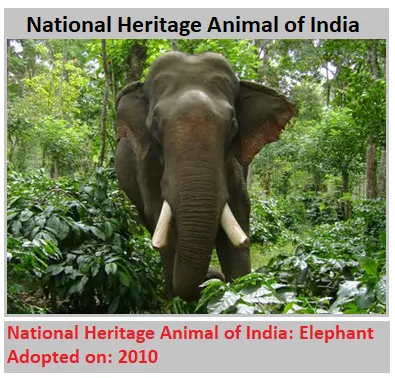
‘Elephants’ have been declared a National Heritage Animal of India by the Government with an aim to take steps for their protection.
When the elephant was declared the national heritage animal of India in 2010, there was excitement and anticipation for better treatments for the creature.
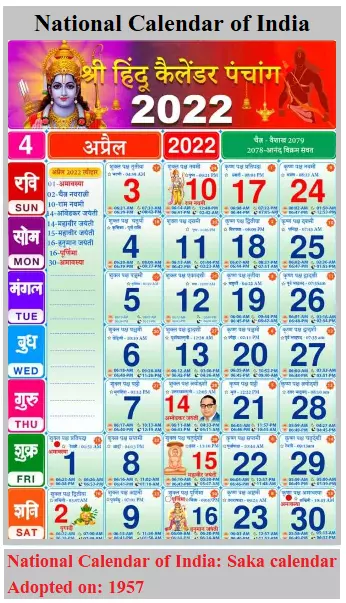
The National Calendar of India is the Indian National Calendar. It is also sometimes called the ‘Saka calendar’.
The national calendar based on the Saka era was adopted along with the Gregorian calendar.
Saka Samvat is a historical Hindu calendar that was eventually established as the 'Indian National Calendar' in 1957.
Chaitra is the first month of the calendar. Chaitra has 30 days and starts on 22 March, except in leap years, when it has 31 days and starts on 21 March.
The names of the months are derived from the old, Buddhist lunisolar calendar, so variations in spelling exist.
The first day of the week is Sunday. The official calendar week considered by the Government of India is Sunday to Saturday.
Our country India does not have any National Language. Many people consider Hindi to be the national language of India but Hindi is not the National Language of India. Hindi is the state language of India. The central government uses Hindi and English as official languages.
According to Article 343(1) of the Constitution, the official language of India is Hindi and the script is Devanagari the arrangement regarding the official language has been made from Articles 343 to 351 of Part 17 of the Constitution.
Hindi was accepted as the official language of India on 14 September 1949. That is why every year 14 September is celebrated as Hindi Diwas.
According to the Eighth Schedule of the Indian Constitution, 22 languages have been selected as scheduled languages of India. These languages are - Assamese, Bengali, Bodo, Dogri, Gujarati, Hindi, Kannada, Kashmiri, Konkani, Maithili, Malayalam, Marathi, Meitei, Nepali, Odia, Punjabi, Sanskrit, Santali, Sindhi, Tamil, Telugu, and Urdu.
Since 2004, the Government of India has accorded classical language status to languages of great antiquity and distinction. By 2021, six languages—Tamil, Kannada, Malayalam, Odia, Sanskrit, and Telugu—have been declared classical languages.
There are only three National festivals in India: Republic Day (January 26), Independence Day (August 15), and Gandhi Jayanti (October 2).
Most Indians consider ‘Khichdi’ as their National dish of India. But there is no national food/dish of India. India has a diverse culture, so does not have any specific national dish. There were rumors that the Indian government was planning to designate khichdi as the national dish of India, but this was later denied by the government.
There is no National Sweet of India. ‘Jalebi’ is considered to be the national sweet of India, but there is no official evidence for this.
Many people consider ‘Hockey’ as the national game/sport of India but there is no national game in India. Our country has an excellent record of eight Olympic gold medals in Hockey.
The Union Ministry of Youth Affairs and Sports says that there is no national sport in India as no sport has been given the status.
“The government has not declared any sport/game as the Indian National Game, as the objective of the government is to encourage/promote all popular sports disciplines”.
‘Bharat Ratna’ is the National Award of India. It is India's highest national award and highest civilian honor. Bharat Ratna is awarded to individuals who have done exceptional work in the fields of science, art, literature, sports, and public service.
The award was instituted on January 2, 1954, by the then President of India, Rajendra Prasad.
The last Governor-General of the Dominion of India and the former Chief Minister of Tamil Nadu – C Rajagopalachari, second President and the First Vice President of India – Sarvepalli Radhakrishnan, and Nobel Prize Laureate and Physicist C. V. Raman, were the first to receive the coveted award in 1954.
There is no National Script of India. The Devanagari script is considered the national script of India, but there is no official evidence for this. According to Article 343(1), Hindi written in the Devanagari script has been called the official language.
The National Motto of India is ‘Satyamev Jayate’, Which means- "Truth alone wins".
It was adopted as the national motto of India on 26 January 1950. It is inscribed in the Devanagari script on the base of the Lion Capital of Ashoka and is an integral part of the Indian national emblem. The emblem and the words "Satyamev Jayate" are inscribed on one side of all Indian currency and national documents.
Satyameva Jayate is a part of a mantra from the Hindu scripture Mundaka Upanishad.
The National Oath of India is an ‘oath of allegiance to the Republic of India.
It can usually be seen printed on the front page of school textbooks.
Pratigya was originally composed in the Telugu language in 1962, by writer Pydimarri Venkata Subbarao.
Its first public reading took place in 1963 in a school in Visakhapatnam, later it was translated and spread to all other regional languages of India.
National Oath Of India
|
भारत हमारा देश है। हम सब भारतवासी भाई-बहन हैं। हमें अपना देश प्राणों से भी प्यारा है। इसकी समृद्ध एवम् विविध संस्कृति पर हमें गर्व है। हम सदा इसके सुयोग्य अधिकारी बनने का प्रयत्न करते रहेंगे। हम अपने माता-पिता, शिक्षकों एवं गुरुजनों का सदा सम्मान करेंगे और प्रत्येक के साथ विनीत रहेंगे। हम अपने देश और देशवासियों के प्रति सत्यनिष्ठ रहने की प्रतिज्ञा करते हैं । इनके कल्याण एवम् समृद्धि में ही हमारा सुख निहित है। जय हिन्द ! |
India is my country. All Indians are my brothers and sisters. I love my country and I am proud of it's rich and varied heritage. I shall always strive to be worthy of it. I shall give my parents, teachers and all elders respect and treat everyone with courtesy . To my country and my people, I pledge my devotion. In their well being and prosperity alone, lies my happiness. Jai Hind ! |
Here we have given you information about the various National symbols of India. The National Symbols of India is also a very important topic from an exam point of view. Being an Indian, you must have information about national symbols.
|
Who made the Indian flag? The Indian Flag was designed by Pingali (or Pinglay) Venkayya. |
|
Who suggested Ashoka Chakra on the Indian flag? Mahatma Gandhi proposed a flag with the charkha or spinning wheel at the center. |
|
Which is the only licensed flag production unit in India? Karnataka Khadi Gramodyoga Samyukta Sangha (Federation) [KKGSSF] in Hubli, Karnataka is the only licensed flag production and supply unit in India. |
|
How many lions are there in Ashoka Pillar? Four |
|
Which country flag is the oldest? The oldest, continuously used national flag is that of Denmark. |
|
Who wrote the national anthem of india? Rabindra Nath Tegore wrote the National Anthem of India. |
|
What is the national song of india? Vande Matrama is the National Song of India. |
|
Who wrote the national song of india? Bankim Chand Chaterjee wrote the national song of India. |
|
What is the national animal of India? Tiger is the national animal of India. |
|
What is the national fruit of India? Mango is the national fruit of India. |
|
Which is the national tree of India? Banyan tree or fig tree is the national tree of India. |
|
What is the national bird of India? The Indian Peacock is the national bird of India. |